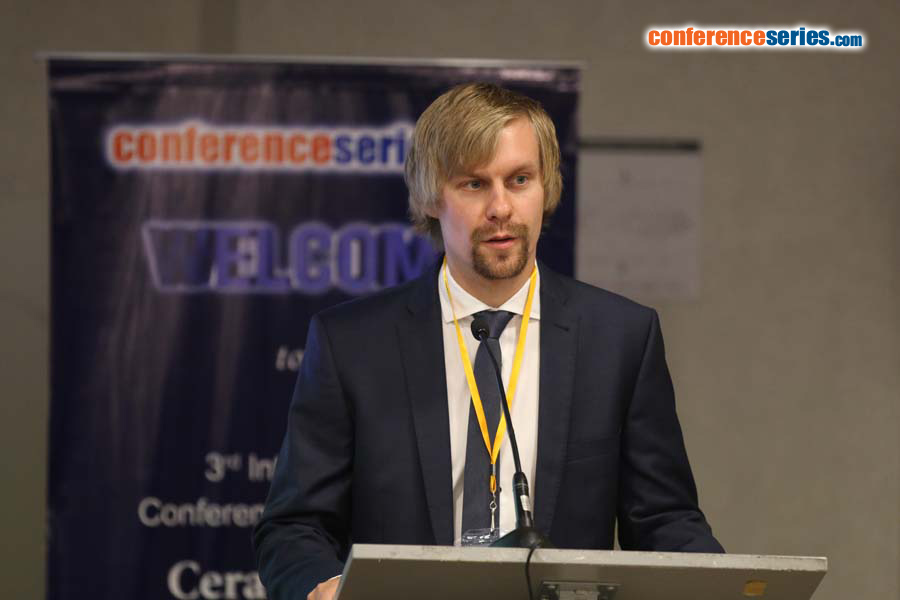
Maik Finsel
University of Hamburg, Germany
Title: Synthesis and thermal stability of monodisperse ZrO2@SiO2 core-shell submicron particles
Biography
Biography: Maik Finsel
Abstract
In recent years, zirconia (ZrO2) micro- and sub-microparticles have attracted considerable attention due to their outstanding properties, including chemical inertness, thermal stability and high refractive index. They are suited for a broad variety of applications ranging from fuel cells, catalysis, electro- and bio ceramics to building blocks in photonic structures. The latter are promising materials for high-temperature applications, including thermal barrier coatings (TBC) and structural colors (SC). The thermal stability, surface smoothness and optical properties of zirconia particles can be improved or modified by encapsulation with a suitable shell material. By using different types of shells, e.g. Al2O3, SiO2, TiO2 or polymers, desired properties of the resulting core-shell composites for various applications are achievable. For example, silica shells ensure a strong refractive index contrast for application as structural colors. Previously, it was shown that silica shells could be grown on ZrO2 cores after surface modification with organic additives (polymer, citric acid). However, such additives most likely preclude high-temperature applications. For the preparation of ZrO2@SiO2 core-shell sub-microparticles, we developed a straightforward approach without the need of additional organic capping agents by using SiO2 seeds as self-adhesive layer. The zirconia core particles were synthesized according to the sol-gel method by Widoniak et al. modified to achieve smaller diameters. In the pre- encapsulation step, silica seeds are formed on the core surface. The silica shell can then grow smoothly on its self-adhesive layer and its thickness is controlled by successive addition of silica precursor. The obtained core-shell particles withstand temperatures up to 1000°C whereas size-comparable zirconia particles disintegrate when heated to 800°C. Also, core-shell particles synthesized using polyvinylpyrrolidone (PVP) as interfacial coupling agent disintegrate when heated to 800°C, most likely due to decomposition of PVP. Using XRD, SEM and cross-sectional TEM characterization, we show how grain growth and phase transitions are influenced by the SiO2 encapsulation of ZrO2 submicron particles. Additionally, the thermal stability can be improved by doping zirconia cores with yttrium or yttrium/lanthanum, as recently shown for zirconia microparticles

Figure 1: Synthesis of ZrO2@SiO2 core-shell particles with PVP as coupling agent (red arrows, according to previous work) and with SiO2 seeds as self-adhesive layer (blue arrows, novel method). After temperature treatment at 1000°C, the shell of the PVP containing particles partially disintegrated whereas most silica shells without interfacial PVP layer stayed intact. Heated zirconia particles (without shell) after 1000°C are shown for comparison (black arrow).
Recent Publications :
- Leib EW, Vainio U, Pasquarelli RM, Kus J, Czaschke C, Walter N, Janssen R, Müller M, Schreyer A, Weller H, Vossmeyer T (2015) Synthesis and Thermal Stability of Zirconia and Yttria-Stabilized Zirconia Microspheres, Colloid Interface Sci. 448:582-592.
- Leib EW, Pasquarelli RM, do Rosário JJ, Dyachenko PN, Döring S, Puchert A, Petrov AY, Eich M, Schneider GA, Janssen R, Weller H, Vossmeyer T (2016) Yttria-Stabilized Zirconia Microspheres: Novel Building Blocks for High-Temperature Photonics, J. Mater. Chem. C 4:62-74.
- Leib EW, Pasquarelli RM, Blankenburg M, Müller M, Schreyer A, Janssen R, Weller H, Vossmeyer T (2016) High-Temperature Stable Zirconia Particles Doped with Yttrium, Lanthanum and Gadolinium, Part. Part. Syst. Charact. 33:645-655.
- Bai A, Song H, He G, Li Q, Yang C, Tang L, Yu Y (2016) Facile synthesis of core-shell structured ZrO2@SiO2 via a modified Stöber method, Ceramics International 42:7583-7592.
- Yang X, Zhao N, Zhou Q, Cai C, Zhang X, Xu J (2013) Precise preparation of highly monodisperse ZrO2@SiO2 core-shell nanoparticles with adjustable refractive indeces, J. Mater. Chem. C 1:3359-3366.
- Widoniak J, Eiden-Assmann S, Maret G (2005) Synthesis and Characterization of Monodisperse Zirconia Particles, Eur. J. Inorg. Chem. 44:3149-3155.
Speaker Presentations
Speaker PPTs Click Here


